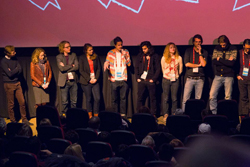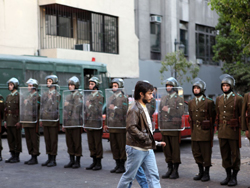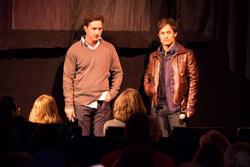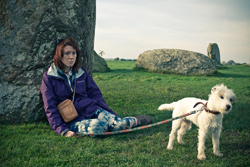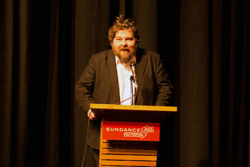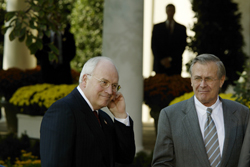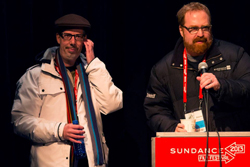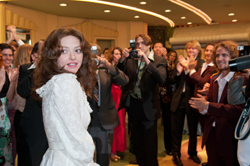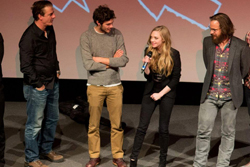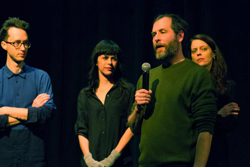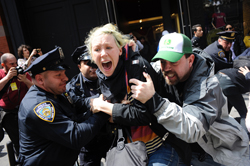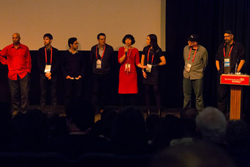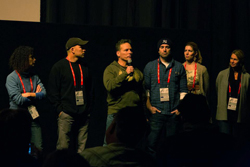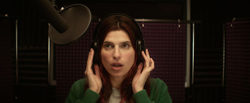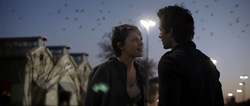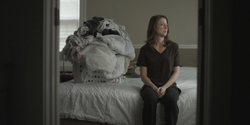Welcome to the Sundance Film Festival 2013 Report
After not seeing any of my favorite indie directors lined up with films at this year’s Sundance and after having to settle for our second and third choice tickets I was pleasantly surprised that I thoroughly enjoyed almost every film we saw this year. I always tell people to go off the beaten track at festivals but I don’t always take my own advice as the Hollywood candy is too hard to resist. That problem was solved this year as we just couldn’t get tickets. It’s still possible to waitlist your way into movies if you are able to show up two hours or more before they start. The people near the front of the waitlist lines almost always get in.
Every festival seems to somehow have an unofficial theme that runs through the films. At Sundance 2013 I noticed these:
Men with beards: The male characters in Sightseers all had beards for no stated reason except perhaps to express the non-conformist, independent-man motif that was abandoned in the 80’s. In a completely different movie, Dirty Wars a (formally) hyper-secret US secret operations force was described as ‘the Bearded Soldiers’. The pictures available revealed that they did (or do) indeed have beards, possibly the reason in this case is to disguise themselves in Afghanistan. At the end of the Q&A for Wajma (An Afghan Love Story) the director said yes we should think about the women who are forced to wear the burka and the men who are forced to wear the beard.
Another theme was mass protests. It felt like one long, continuous, bloody, news reel from The Stuart Hall Project, to No and then 99% The Occupy Wall Street Collaborative Film.
When is it right to kill (or torture) someone was the topic of most of The World According to Dick Cheney, Sightseers and Dirty Wars.
Reinvention of ourselves or “controlling the narrative” was a theme in Concussion, Upstream Color, The Stuart Hall Project and 99% The Occupy Wall Street Collaborative Film.
There was a technical theme as well. It wasn’t 3D this time as the only 3D film at the festival (Charlie Victor Romeo) had a technical glitch and had to be shown in 2D at our showing. Rather it was authenticity. No, Computer Chess and Stories We Tell went to extreme measures to match archival footage. In each case using a vintage camera rather than post processing tape from a modern camera.
As always there are films we wish we had seen: Fruitvale is a dramatization of the last day of life for Bay Area resident Oscar Grant who was executed by BART Transit Police Officer Johannes Mehserle on New Year’s Day 2009. The incident was filmed on multiple cell phone cameras and seen by millions via the internet. Mehserle’s defense in court was that he thought he was using his Taser. This person was released early from a three year sentence for Manslaughter. Here is a brief list of things that a person who cannot tell the difference between a gun and taser should not be allowed to do:
- Own or operate a gun or taser
- Drive
- Have children
- Be in public without supervision
Fruitvale won both the Grand Jury Prize and Audience Award for drama.
Here are my reviews for the movies we did see: No
A fascinating film about the 1988 plebiscite (a yes or no referendum) on Augusto Pinochet the ruthless Chilean dictator installed by the CIA led coup on September 11, 1973. The vote was of course not something that this man would choose to do, he was forced to do so by international allies (i.e., the US), I guess we have our limits.
The story is told through the experience of an advertising executive, Rene’ Saavedra, played by Gael Garcia Bernal (Y Tu Mama Tambien, Amores Perros) who was recruited by the ‘No’ side. His approach was to focus on positive messaging rather than attack Pinochet. “Chile: happiness is coming.” Rene’s boss at the same agency served as the head of the ‘Yes’ campaign.
Like Argo, this movie is another great way to learn a little slice of world history, especially the history created by our own CIA. But perhaps the primary focus is on the role advertising plays in modern elections and in our lives. Specifically in this case, the insistence on a relentlessly positive message in the face of an opponent who has obvious and admitted human rights atrocities on his record is reminiscent of the recent elections in the US. Makes you wonder if this Chilean referendum was a lesson that they all study. At the same time that this advertising agency is focused on both sides of this incredibly critical campaign they are also working on an ad to promote a Chilean soap opera. This dual nature takes a toll on the advertising execs, especially Rene’ Saavedra, and to the extent that we as individuals are influenced by advertising, it takes a toll on us as well.
OF course, as in all elections, the “counting” of the vote is what matters and there are a couple of quick scenes suggesting that the outcome was predetermined. This movie follows a current trend I’ve seen to not beat the audience over the head with excessive exposition. Paying attention pays off. This movie is the third part of a trilogy by director Pablo Larrain. The first two, Tony Manero and Post Mortem sound as if they present their take on Chilean history in a more symbolic fashion; I’ve added them to my Netflix.
We couldn’t stay for Q&A as we had to get to another movie, but I heard one question about the technology used to shoot the film. The filmmakers had to use original Sony Betamax cameras to match the look of news tapes from the era. They initially tried post processing digital tape from a modern camera but it didn’t look right. Go analog!
Sightseers
With typical English self deprecation director Ben Wheatley had the audience in stitches with a few sentences before the film started… “We focus-grouped various movie topics and found that small dogs and 80’s pop were the most likely to make us rich…” This put is all in a laughing mood which was good since this film will certainly be too violent for some. If you appreciate dark English humor (the Sundance film guide referred to it as ‘pitch-black’) or simply want to stick it to the man as much as I do then you’ll be fine but some of folks in my crew were a bit perturbed by it all.
“Chris” is the new boyfriend of overly sheltered “Tina”. As they are embarking on a tour of kitschy English tourist sites Tina’s mother shouts ‘Murderer!’ It’s not clear who she is addressing but we learn that it is Tina herself as flashbacks reveal an unfortunate event with knitting needles and her mother’s beloved Terrier. But maybe the mother is on to something because as the trip unfolds we find out that Chris makes a hobby out of eliminating little bits of the upper crust.
Since we try to avoid reading too much about movies before seeing them we didn’t know what was coming but it would be unwise for the filmmakers to try to put this film out without due warning so the trailer (http://www.youtube.com/watch?v=qyg9aRqlUxM) will fill you in. I wonder if I myself have become desensitized to violence in film. Personally I recoil at even the descriptions of what is in most video games but in movies it just doesn’t bother me anymore, I don’t take it as real. It can bore me however, have you seen The Hobbit? Whatever our personal reactions are it doesn’t mean that it’s right or even ok to depict violence in movies (or video games). The question of does it have a negative impact on society?
In its expression of not only the frustration of the working man but also the damage that the working class can do to itself by taking it all too far, this movie does have a message. Not sure how much that will get through given the mixture of laughs and over-the-top violence.
Sundance referred to director Ben Wheatley as ‘genre-bending’ in that he has taken the tried and true travelogue film and turned it on its head and then twisted it around. The sites visited are those that he and co-writer Alice Lowe visited as children. In typical travelogue fashion it is interesting to see the sites. These happen to be at the fringes of the tourist map so it’s likely we will never visit them.
The performances are strong in this film. Perhaps that’s because the actors playing the couple were the authors of the script but the director had an interesting technique as well, he started filming scenes two minutes ahead of the planned shot and let it run through. Could make for an interesting extended version on the DVD.
The Stuart Hall Project
A tribute to Jamaican born, Oxford educated sociologist who, I have learned, taught sociology and represented the left on Brit political talk shows during the 80’s and 90’s. He became a hero to many in that country and hence we have this film.
One of many films making extensive use of archival footage at Sundance this year, this one stands out however as they were tapping the extensive BBC archives not only for protest and riot footage but some fascinating little slices of daily life in the UK. The concurrent voiceovers are from interviews with and talks by Stuart Hall much of which is too academic to comprehend fully in this fashion. The subjects range from the cold war to Mods vs. Rockers. During some of the times that I could tear myself away from the visuals to focus on the message I became a bit annoyed as the statements were quite general and presumptuous but that is what sociology is about. How do I get one of those jobs?
I’m thinking that most of us, especially in the US, would enjoy the movie more if we knew more about Stuart Hall. Why is he a hero? There is one scene in the film where he confronts a conservative rival on a TV news show. More of this might have been enough to let me know who this man is and why I should listen to him.
I still give this movie a mild recommendation for the extensive BBC archive footage and the wonderful soundtrack including what seems like a dozen different Miles Davis tunes as well as ambient music from the ECM label and Brian Eno.
World According to Dick Cheney
The title sums it up, a recount of the Bush years via an extensive interview with the man in charge, Dick Cheney. The first third of the movie had me thinking that it was a puff piece with no significant counterpoint offered to the former VP’s version of events. However, the facts have a liberal bias so there is no way to put a positive spin on what happened in the second Bush administration. Even Bush himself lost faith in the man and the movie presents it as a personal story. A story that was not evident in the news at the time (as I recall). The turning point revolved around the Justice Department’s agreeing (as Cheney had been reporting up the chain) or disagreeing (as was the case in reality) with the classification of ‘enhanced interrogation’ torture techniques as acceptable under the Geneva conventions and US law.
Cheney does not deny his political acumen, the opening of the film recounts Cheney’s miraculous rise to power going from Yale-dropout with two DWI convictions at age 21 to White House Chief of Staff for Jerrold Ford 11 years later. During the post-film Q&A many questions came up asking if the former VP had manipulated the film makers as well. They answered that Cheney probably thinks that he did.
There were only a couple of things that he wouldn’t talk about and while he is remarkably composed and calm throughout (writer James Mann has said that “Cheney’s voice is a colorless odorless gas that conveys competence) the filmmakers commented that were two times that they noticed a crack in the smooth veneer. When he was asked to talk about what (then) girlfriend Lynn Cheney had said exactly when telling him that his drinking was a problem and while insisting that ‘enhanced Interrogation was ‘legal, moral and effective’.
Before the film director RJ Cutler stated that Cheney was arguably the most important (powerful) non-presidential political figure of our lifetime. It was his previous experience in making political documentaries (The War Room, The Perfect Candidate) that won the day and got Cheney to agree to the 20 hours of interviews. Others, including Rumsfeld are interviewed as well. With many people in the audience still upset over the political and economic damage inflicted on the US by the Bush administrations many questioners were thinking that the movie was too soft on Mr. Cheney. The filmmakers intimated that a different, longer version of the movie is possible. Another one to check out on DVD.
Dirty Wars
While The World According to Dick Cheney had me (re)outraged about the atrocities of the Bush era, Dirty Wars provided no relief while documenting what is going on currently. Consider this from the timeline provided in the press kit for Dirty Wars:
2009
January 22 | President Barack Obama signs Executive Order 13491. The new order stipulates that detainees in the war on terror shall “all circumstances be treated humanely and shall not be subjected to violence to life and person (including murder of all kinds, mutilation, cruel treatment, and torture), nor to outrages upon personal dignity (including humiliating and degrading treatment).”
January 23 | Obama carries out this first drone strike, in Pakistan. Between seven and eleven civilians, including one child, are killed, according to news reports.
We are told that the targets are deserving, and that the civilian casualties are minimal. Right. You might question how it is that any civilian casualties are ‘acceptable’ but getting some actual reporting on the actual numbers and actual people leaves little room for acceptance. The drone strikes that killed US citizens Anwar Al Awlaki, Samir Khan and 16 year old Abdulrahman al Aulaqi , all US citizens, are the primary focus of this film.
Amazingly, one audience member walked out after asking his pointed question about how the filmmakers felt about implying that the US President had done something illegal. Actually, the film does a good job of covering the way in that, in secret, our government has concocted a notion that this activity is right and legal.
Unlike Gatekeepers, which is hitting theaters now after playing at Telluride and Sundance, this is not a talking-heads documentary. Rather it’s a personal story of the reporter’s process of discovery. This film is full of beautiful footage from Canon 5D and Panasonic EX-1 cameras. Ease of transport was the reason for choosing these (more) affordable cameras but they also delivered the Cinematography Award for the US Documentary category. Original music by the Kronos Quartet (who typically performs other’s music) is part of the score.
Lovelace
Staring Amanda Seyfried, Peter Saarsguard, Chris Noth, James Franco, Sharon Stone and others this movie had far and away the most star power of any we saw at Sundance this year. The movie tells the story of Linda Lovelace and the movie Deep Throat in two versions. One, the version as experienced in the popular culture in the 70’s and two, the version as told by Ms. Lovelace (Linda Susan Boreman) in her autobiography ‘Ordeal’.
If you are not familiar, in ‘Ordeal’ Ms. Lovelace revealed that she was the victim of an abusive husband and was forced to perform in the famous film by her husband and mafia figures involved in the production. This allegation has been repudiated by her former husband (Chuck Traynor) and others and while they lack credibility, Linda Lovelace herself muddied the waters or at least made the story considerably more complicated with some of her subsequent words and actions.
Nonetheless it is a story well worth telling and the filmmakers stated a laudable goal before the film, they ‘wanted to show Linda Lovelace’s humanity’. I’d give them a B on this effort. The movie is worth seeing (not as a date movie!!!) but it simplifies the story to what is basically an introduction to the topic and an escape-from-bondage story. We see a standard R rated, semi-explicit version of the sex, and a fully explicit version of the violence of this marriage. But the movie stops abruptly at 93 minutes just when it would have the chance to meet the filmmakers stated goal.
I Used to be Darker
In the post-film Q&A I had to ask the filmmakers what the title was referring to. It’s a lyric from a song by Bill Callahan (aka Smog): ” I used to be darker, then I got lighter, something too big to be seen was passing over me. ” This level of music appreciation explains the rest of the movie well. The plot is the story of the breakup of a musical couple. He has moved on from music as his primary occupation in order to better pay the bills while she remains focused on it. This seems to be what has driven them apart. I usually do all I can to avoid spoilers in these reviews but that last sentence there is just about the entire story. There are some subplots and accessory characters but really that’s about it. Much of the rest of the time is taken up by having one or the other of the couple perform a song, an entire song. The two playing the couple are indeed musically talented, Ned Oldham, brother of Will (aka Bonnie Prince Billie) plays “Bill” and singer songwriter Kim Taylor plays “Kim”, the other half of the couple. And their musical performances are more moving than their acting performances so it makes some sense to do this. But if there were more story to tell the filmmakers would certainly have cut these songs short in order to tell it. Yes the songs relate directly to what is happening in the movie at the time but still, it becomes more of a recap rather than something that moves the story. Ok, I’ve complained pretty vigorously about this but in the end watching this movie wasn’t terrible; it was average for an indie drama. This one is worth streaming from Netflix someday, it will be in theaters at least in NY and LA as it was picked up for distribution late in the festival.
99% The Occupy Wall Street Collaborative Film
This movie was down on my list because I assumed it would be a messy hodgepodge of collected cell phone videos. I was incorrect. It was the most cogent and far reaching of all of the issue(s) based docs that we saw. I think some reviewers out there can’t get past their own preconceived notions about the occupy movement however. The review in Variety magazine calls it “A doc as messy as the movement it tries to portray”. He goes onto say that the movie doesn’t go into enough depth for each of the issues that it touches upon. Enough with trying to dumb things down to the 8th grade level ok? The movie is tight, well organized and insightful. It does indeed cover multiple issues as does the movement itself. The footage is not collected from cell phones but is the product of organized film making began by filmmakers Audrey Ewell and Aaron Aites as the occupy movement began.
On the bus ride away from the screening Audrey told me that she has always been interested in movements. Her first full length doc was Until the Light Takes Us a chronicle of Norwegian black metal – a particularly dark subgenre of music. In this film she relies heavily on interviews with Matt Taibbi and Naomi Wolf as well as the collected footage. I consider myself to be reasonably well informed but was (un)pleasantly surprised to learn several new things while watching this. For instance, the media at all Occupy sites nationwide was expertly suppressed by the police when they told reporters that they would lose their press credentials if they stayed at the occupy site. This was several weeks before the nation-wide coordinated shutdown of the protests. Also, student loans have been securitized and sold to institutions just like mortgages.
This movie received the longest most enthusiastic standing ovation that I have ever seen for a film. Power to the people!
Inequality for All
Perhaps as an answer to the Variety critic’s prayers this movie focuses intently on just one idea. The health of a society and economy depends on a reasonable degree of income equality. The person presenting the idea is former U.S. Labor Secretary Robert Reich who served during the first Clinton administration. The movie presents in detail the idea that concentrating wealth at the top (presently 400 families in the US have more wealth than one half (150 million) of the rest of us) deprives everyone and starts a vicious cycle of decline as the middle class becomes less able to maintain families and educate their children, forcing them to take less productive jobs and so on. Contrast that with the model of Germany (for instance) where the vast majority are educated to a high level enabling that society to produce and profit from the largest portion of the iPhone (for instance). Yes, Germany takes home a bigger slice of the Apple pie than does the US, China or Japan. The film explains and presents this phenomenon in detail with filmed lectures by Robert Reich, very well done graphics and interviews.
This movie won the U.S. documentary special jury award at the festival and more importantly won a distribution deal from Harvey Weinstein’s Radius. I expect it will be in theaters but how to get people to see it?
Charlie Victor Romeo
I might not be able define pornography but I know it when I see it. This film is adapted from stage plays re-enacting the words and actions of pilots involved in airline crashes. After the movie the directors pointed out that no one is allowed to hear the actual recordings themselves but the transcripts are available. But to what end? In a rather unconvincing explanation they said that their original intent was to make this material, and a depiction of how pilots reacted under the stress of these extremely awful situations, available to airline industry professionals. I agree that this could be of some use. They went on to say that since we are all destined to encounter stressful situations in our lives these recreations are useful for all of us. Give me a break. The movie encapsulates the extreme suffering and death of real people as entertainment. If you still had a local video rental store it would be on the ‘snuff film’ shelf.
In order to heighten our experience of these people’s demise the movie was to be shown in (Dolby) 3D. Before the film one of the directors said that he finds this version of 3D to be different and beautiful as compared to the typical Real 3D used in most US theaters. I covered these 3D formats in my 2010 Telluride Film Festival available in the Secrets archive. I agree that Dolby is a better format but I wouldn’t stretch it to ‘beautiful’. I still find the visuals to be mildly annoying. In this case then I couldn’t tell for sure that something was way wrong with the 3D projection system, I was finding it annoying as usual, with odd waves of dark shadows around the actors heads but I knew I wasn’t enjoying it. Turns out the system was malfunctioning and after 40 minutes and two attempts at rebooting they decided to show it in 2D.
Computer Chess
This movie most closely resembles a Christopher Guest type mockumentary but it has a bit more heart and less snark. The subject in general is the 1980’s. Specifically it’s a weekend at a hotel hosting a computer chess tournament. Though the players are from MIT and Cal-Tech the setting is decidedly small-time as would have been the case in those days. Also as it happens there is a small gathering of EST (Erhard Seminars Training) practitioners competing for the same hotel convention space. There is not a strong plot connecting the events, it’s much more of a you-are-there type of movie, so much so that the audience was probably thinking it was an actual documentary for the first 20 minutes or so. The thing is, the filmmakers love their subject so much it might as well be a documentary, it just feels right.
One of several movies we saw where the film makers went to extraordinary lengths to get an authentic look. In this case they found an old Betamax camera as well as a retired Sony technician who lived in the area that helped them keep it running. They tried filming with a modern camera and using post processing to get the same – blurred black and white video – look but it just wasn’t the same. This is something we heard from the filmmakers of No as well.
Stories We Tell
The fourth feature directed by the uber-talented Sarah Polley, and the first documentary, this one was easily the most moving and by far my favorite at this year’s festival. A highly personal film about Ms. Polley’s own family, it has been in production for five years and after it was a smash hit at all three of last fall’s major film festivals (Telluride, Toronto, Venice) I was surprised to see that it still hasn’t been picked up for distribution. Even after an equally enthusiastic reception at Sundance there is apparently no deal in the works.
The story is about the origin of Sarah herself as told by various family members and family friends. Since Ms. Polley’s parents were both actors it was easy to believe that the amazing amount of super 8 footage used in the movie was actually shot back in the 70’s but we learned in the Q&A that 80% of that footage is from recreations. Sarah went on to say that she didn’t really intend to fool the audience but since so many of those involved with the film were dedicated to the craft, including the production designer who ‘tested every Super-8 camera and film stock in Canada’ it just turned out that way.
I could go on about what happens but it’s so much better for you to see this yourself and I don’t want to spoil it. If you do see it, and you can think back to this review, here’s something else that Sarah said in the Q&A (paraphrased) “when the one key figure that I won’t mention by name met the other key figure that I won’t mention by name he said, “Thank you for giving me one of the best things in my life”.
Blackfish
Killer Whales in captivity. For our enjoyment. Do we think they are happy about that? Blackfish is a compelling documentary that answers the question. Similar to what The Cove has done to reveal the true story of Dolphins held in captivity, Blackfish shows us the brutal capture and captivity of these magnificent animals that have language and a brain that is larger than our own.
While SeaWorld in Florida sets the standard for care of these animals they still have not been able to prevent the death of a ‘trainer’. Wait till you see some of the other places in the world that also keep these animals. Thankfully, in the case of Sea World, OSHA has noticed that these might not be the safest working conditions and have taken some action against the park.
In a World
The funniest movie we saw at Sundance this year. Writer/Director Lake Bell was first noticed by Sundance due to her submission of a short film for the 2011 Sundance Festival. For this movie she worked as the writer, director and star.
When Ms. Bell landed in LA she did some work as a voice over actor which gave her the impetus for this movie which lives in that world. Specifically, the world of voice over actors in the wake of the death of Don LaFontaine, the most famous voice over actor and the one charged with uttering the phrase “In a world..” at the start of movie trailers. After a respectful amount of time the industry is ready to hand that line to another voice, but who will be chosen?
This movie is funny in part because Ms. Bell has respect for the world she is sending up and because she is just a good writer. It seems like not a single scene went by without an uproar from the audience.
It does touch upon important themes however, especially sexism. After the film a special thanks was given to Geena Davis who has a cameo in the movie. Ms. Davis was a natural for this as her current pursuit is the Geena Davis Institute on Gender in the Media.
Upstream Color
This film was far and away the favorite topic for discussion at this year’s Sundance. The writer/director/producer/actor/sound artist/cinematographer/editor (septtuple threat Shane Carruth) is planning to distribute the film himself (make that octuple threat) in NY and LA only at this point. Maybe with all the excitement he will yet get a deal for distribution but if so, it would require some careful marketing. Like a David Lynch film this one walks the line of obscurity and abstraction while attempting to feed the viewer with no more than is needed to piece together the not-run-of-the-mill story.
Here’s a version of the story: Protagonist Kris (Amy Seimetz) is attacked in alleyway after work, a parasitic worm is injected into her mouth, a parasite that allows (somehow) the attacker to control her – and get her to sign over all her money over the next few days. She wakes up a month later and realizes that something has happened but she doesn’t know what. Having lost her job and savings she must now find some way to get on. At the screening we attended the director indicated that this loss of identity and the subsequent reinvention was all that he wanted to portray. This is something that we could all relate to as life sends us this way and that. However, the movie is so rich with metaphor and symbolism that it’s hard to believe there are not other meanings being conveyed. For instance, Kris and some other victims of this same scheme were all engrossed in reading Walden by Henry David Thoreau and in the end a ‘return to the earth’ theme plays a prominent role. Kris’ relationship with fellow victim Jeff (Shane Carruth) make up the bulk of the movie as they work to find the answers together. Forgive yourself though if you can’t tell what they are doing or why for 90% of the film. I think each scene does have a meaning and clue leading to the conclusion but the director’s discussion after the film confirm that even he may not have a concrete idea of the plot points. Not surprising then that the film can be interpreted as a personal story as described above or as a larger allegory for humankind’s relationship with nature.
If you venture to see this movie many things will go by without explanation but if you can live with that you might enjoy many hours of discussion in attempting to figure it all out, as did this year’s Sundance attendees. Maybe we’ll get a director’s commentary on the DVD.
Concussion
Even though this movie has what sounds like a daring premise: a woman in a committed lesbian relationship, with children, gets fed up with kids and feeling a mid life crisis decides to become a (lesbian) call girl, it felt to me most like a ‘movie’ of all the films we saw at Sundance this year. In other words, it didn’t seem to have that much to say. Perhaps I’ve been living my own midlife crisis for too long. Not that I ever tried being a lesbian call girl… though there was that one time. Anyway, comments from the audience made the obvious comparisons to Belle du Jour and director Stacie Passon remarked that she felt that it was important to honor the filmmakers that influenced her. The movie was picked up for distribution though it will certainly be in art houses only.
Fans of HBO’s Deadwood might want to see this to catch up with Robin Weigert who puts in a compelling performance, perhaps saving the film from the dustbin.
What They Don’t Talk About When They Talk About Love
An Indonesian film – perhaps the first I’ve ever seen – set in a high school for the visually impaired, we follow three girls, Diana, Fitri and Maya as they approach womanhood, start a relationship with a hearing impaired punk rocker and aspire to be a (musical and theater) performer respectively. I got that from the Sundance festival program however as watching the film doesn’t necessarily tell you all that. There is very little in the way of dialogue and instead there are just various strange goings-on that are hard to decipher.
An interview with the director in the press kit for the film reveals that there is an alternate reality, where the characters can see/hear/speak. Actually a different alternate reality for each of the three girls. Didn’t get that. Also, this movie delves deeply into that ‘foreign film’ territory of making the audience feel the characters’ world “through deliberate silences, languid tracking shots down corridors, and highly choreographed movement.” Problem is, that also puts the audience to sleep – just when they need all of their faculties available in order to figure out what the heck is going on.
Wajma (An Afghan Love Story)
The news happening below the headlines in Afghanistan is that a middle class is forming in the big cities, affording young women and men the chance to meet. What happens next is natural. What happens after that is cultural. Unfortunately in this case that is still a culture that would advise killing a daughter who becomes pregnant outside of marriage. So stringent are the rules still that Afghan filmmaker Barmak Akram told authorities that he was shooting a documentary. ‘I am a bandit’ he told the audience after the film.
This movie has some fantastic performances by Wajma Bahar who plays the daughter and Hadji Gul in the role of the father, not that you will like him. This is a tough film to watch. We didn’t have tickets for the film but it was no problem getting in. I was handed a ticket for free while standing in the wait list line.
The director said he does have plans to show it in Afghanistan but that will have to be on-the-sly. There is a movement for social change he said, ‘because there is rock and roll’.



